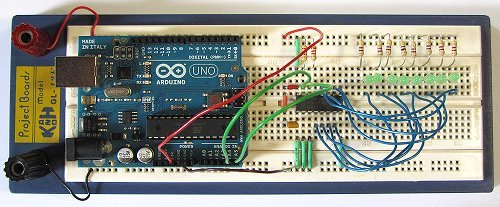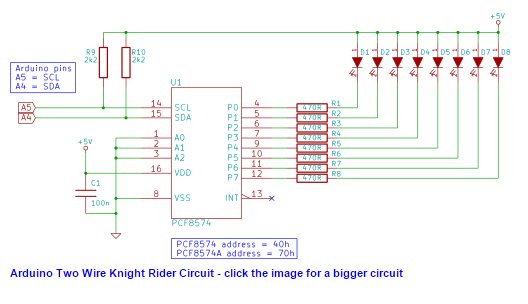This tutorial shows how to interface eight LEDs to an Arduino using only two Arduino pins. This is made possible by using a PCF8574 I/O expander IC. A “Knight Rider” display is shown on the LEDs.
Prerequisites
Complete tutorial 4 – Arduino Knight Rider. Be able to use DIP IC packages, e.g. from tutorial 17.
Components
In addition to an Arduino Uno board, USB cable, wire links and a breadboard, you will need:
| QTY | PART | DESIGNATOR | NOTES | TYPE |
|---|---|---|---|---|
| 2 | 2k2 resistors (red – red – red) | R9, R10 | 1/4W 5% or better | Resistors |
| 8 | 470 ohm resistors (yellow – violet – brown) | R1 to R8 | ||
| 1 | 100n capacitor | C1 | Non-polorized capacitor | Capacitor |
| 1 | PCF8574P | U1 | 4047 IC e.g. CD4047 (14 pin IC) | Semiconductors |
| 8 | LEDs | D1 to D8 | LEDs – red or green 3mm or 5mm diffused LEDs |
Circuit Diagram
In this circuit diagram, the Arduino board is not shown. Only the pin labels of the Arduino pins to be connected to the PCF8574 (U1) are shown. The points marked +5V are to be connected to the Arduino 5V pin. The inverted triangle (GND) is to be connected to one of the Arduino GND pins.
Building the Circuit
The photo below shows the complete circuit built on breadboard. Click the photo for a bigger image.
The suggested sequence of building the circuit is:
- Insert the PCF8574 IC
- Make power and ground connections to the IC
- Connect pin 1, 2 and 3 of the IC (U1) to ground
- Insert capacitor C1 (100n) and wire it between power (5V) and ground (GND)
- Insert the eight LEDs with anodes (longer pin) on the left
- Connect resistors R1 to R8 between the LED anodes and the top breadboard rail (5V)
- Wire the cathode of each LED to the correct pins on the IC
- Connect R9 and R10
- Connect the two wires from Arduino pins A4 and A5 to the IC
- Connect the Arduino 5V to the top breadboard rail and GND to the bottom breadboard rail
You may have noticed that the breadboard circuit swaps the position of the LEDs and resistors from the circuit diagram – e.g. R1 and D1 swap positions. This will make no difference to how the circuit operates. It has only been done to simplify the breadboard circuit.
Programming the Arduino
Copy the two_wire_knight_rider sketch below and paste it into the Arduino IDE.
/*--------------------------------------------------------------
Program: two_wire_knigh_rider
Description: Uses a PCF8574 IO Expander IC on the Arduino
TWI bus to interface 8 LEDs. A "knight
rider" display is shown on the LEDs.
Date: 25 April 2012
Author: W.A. Smith, http://startingelectronics.com
--------------------------------------------------------------*/
#include <Wire.h>
// address of PCF8574 IC on TWI bus
#define IO_ADDR (0x40 >> 1)
void setup() {
Wire.begin(); // initialize the I2C/TWI interface
}
void loop() {
static unsigned char data = 0x01; // data to display on LEDs
static unsigned char direc = 1; // direction of knight rider display
// send the data to the LEDs
Wire.beginTransmission(IO_ADDR);
Wire.write(~data);
Wire.endTransmission();
delay(70); // speed of display
// shift the on LED in the specified direction
if (direc) {
data <<= 1;
}
else {
data >>= 1;
}
// see if a direction change is needed
if (data == 0x80) {
direc = 0;
}
if (data == 0x01) {
direc = 1;
}
}For more detail: Two Wire Arduino Knight Rider


